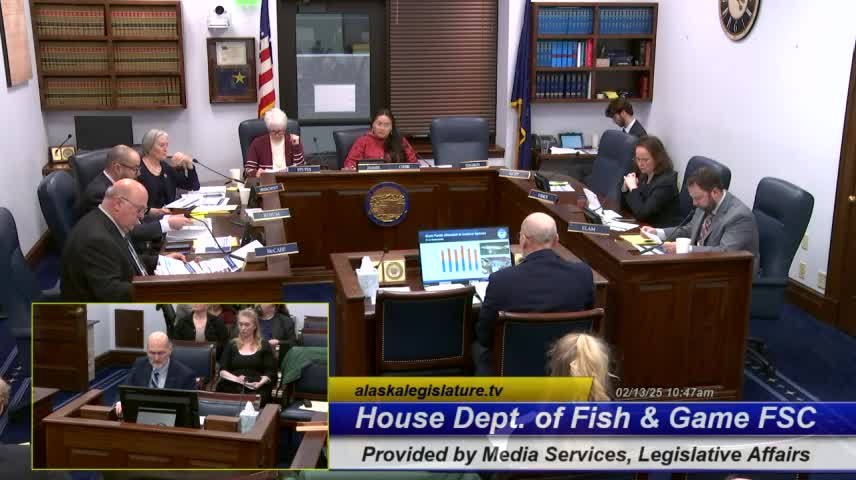Alaska fisheries coordinator secures federal funding for invasive species management
February 13, 2025 | 2025 Legislature Alaska, Alaska
This article was created by AI summarizing key points discussed. AI makes mistakes, so for full details and context, please refer to the video of the full meeting. Please report any errors so we can fix them. Report an error »

During a recent meeting of the Alaska Legislature's House Fish and Game Committee, significant discussions centered on the management and funding of invasive species programs and hatchery operations, highlighting their critical role in supporting local ecosystems and recreational fishing.
The committee learned that funding for invasive species management has averaged around one million dollars annually over the past five years, primarily sourced from federal grants. These funds are essential for addressing invasive species issues across various regions in Alaska, including efforts to combat zebra mussels and signal crayfish. The statewide coordinator collaborates with multiple agencies to tackle these challenges, emphasizing the importance of inter-agency cooperation in managing invasive species that threaten local habitats.
Representative Henshoot raised questions regarding the sources of funding for these initiatives, confirming that while federal grants are the primary source, there is a state match component involved. This partnership underscores the reliance on both federal and state resources to effectively manage invasive species.
The discussion also turned to the operational budgets of hatcheries in Anchorage, Fairbanks, and Southeast Alaska, which collectively account for a significant portion of the division's budget. With over $8.8 million allocated for hatchery operations, the committee noted the importance of maintaining these facilities to ensure a steady supply of fish for sport anglers. Capital appropriations totaling nearly $10 million are earmarked for various hatchery upgrades, with specific allocations for the Crystal Lake Hatchery and others.
The meeting highlighted the Dingle Johnson Act, which funds sport fish restoration through excise taxes on fishing equipment and motorboat fuel. This program is crucial for sustaining fishing opportunities in Alaska, as it directly ties user fees to the enhancement of fishery resources.
As the committee concluded, members expressed a desire for more detailed insights into revenue sources and the financial benefits of these programs to local communities. The discussions underscored the ongoing commitment of the Alaska Legislature to support sustainable fishing practices and the management of invasive species, ensuring that both the environment and local economies can thrive.
The committee learned that funding for invasive species management has averaged around one million dollars annually over the past five years, primarily sourced from federal grants. These funds are essential for addressing invasive species issues across various regions in Alaska, including efforts to combat zebra mussels and signal crayfish. The statewide coordinator collaborates with multiple agencies to tackle these challenges, emphasizing the importance of inter-agency cooperation in managing invasive species that threaten local habitats.
Representative Henshoot raised questions regarding the sources of funding for these initiatives, confirming that while federal grants are the primary source, there is a state match component involved. This partnership underscores the reliance on both federal and state resources to effectively manage invasive species.
The discussion also turned to the operational budgets of hatcheries in Anchorage, Fairbanks, and Southeast Alaska, which collectively account for a significant portion of the division's budget. With over $8.8 million allocated for hatchery operations, the committee noted the importance of maintaining these facilities to ensure a steady supply of fish for sport anglers. Capital appropriations totaling nearly $10 million are earmarked for various hatchery upgrades, with specific allocations for the Crystal Lake Hatchery and others.
The meeting highlighted the Dingle Johnson Act, which funds sport fish restoration through excise taxes on fishing equipment and motorboat fuel. This program is crucial for sustaining fishing opportunities in Alaska, as it directly ties user fees to the enhancement of fishery resources.
As the committee concluded, members expressed a desire for more detailed insights into revenue sources and the financial benefits of these programs to local communities. The discussions underscored the ongoing commitment of the Alaska Legislature to support sustainable fishing practices and the management of invasive species, ensuring that both the environment and local economies can thrive.
View full meeting
This article is based on a recent meeting—watch the full video and explore the complete transcript for deeper insights into the discussion.
View full meeting
